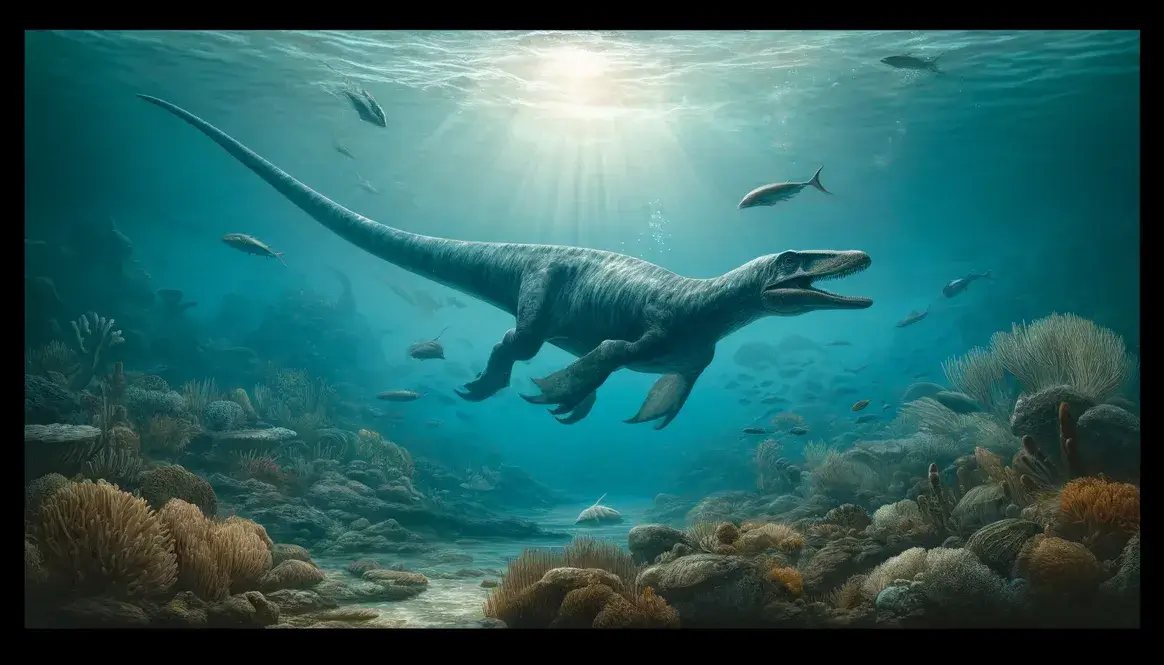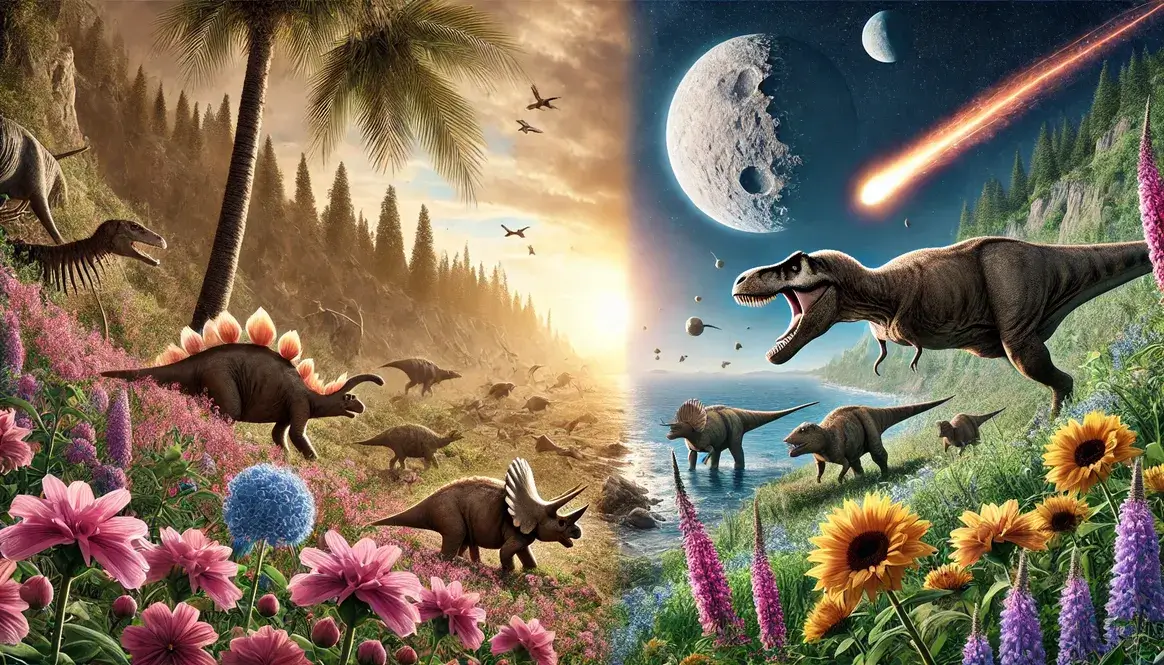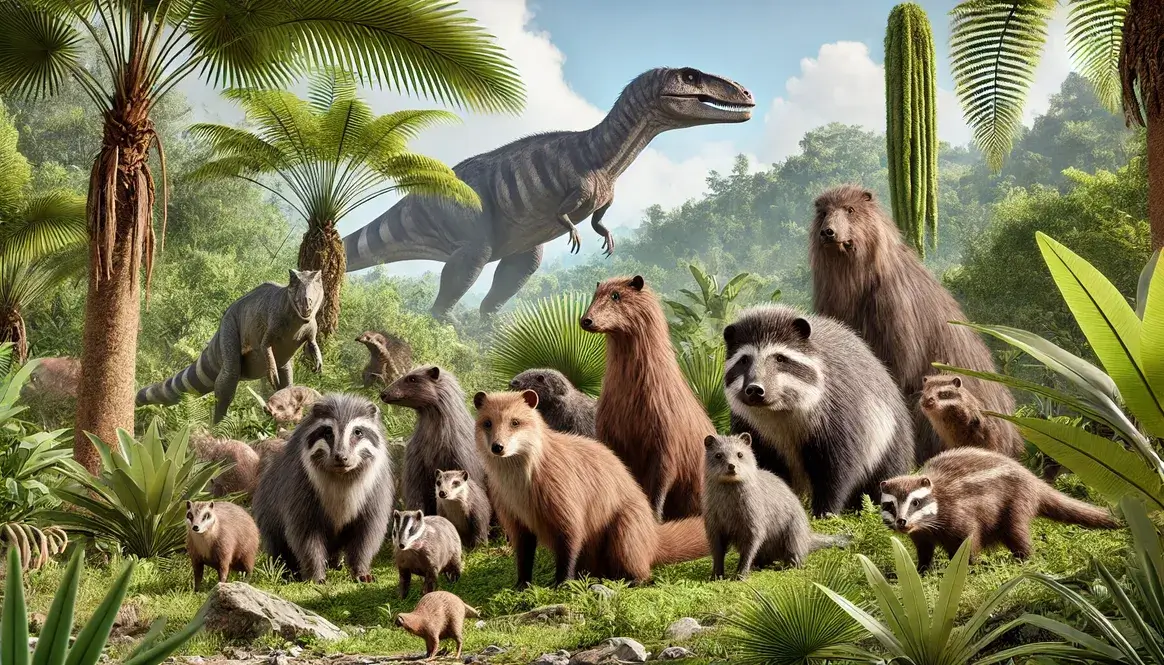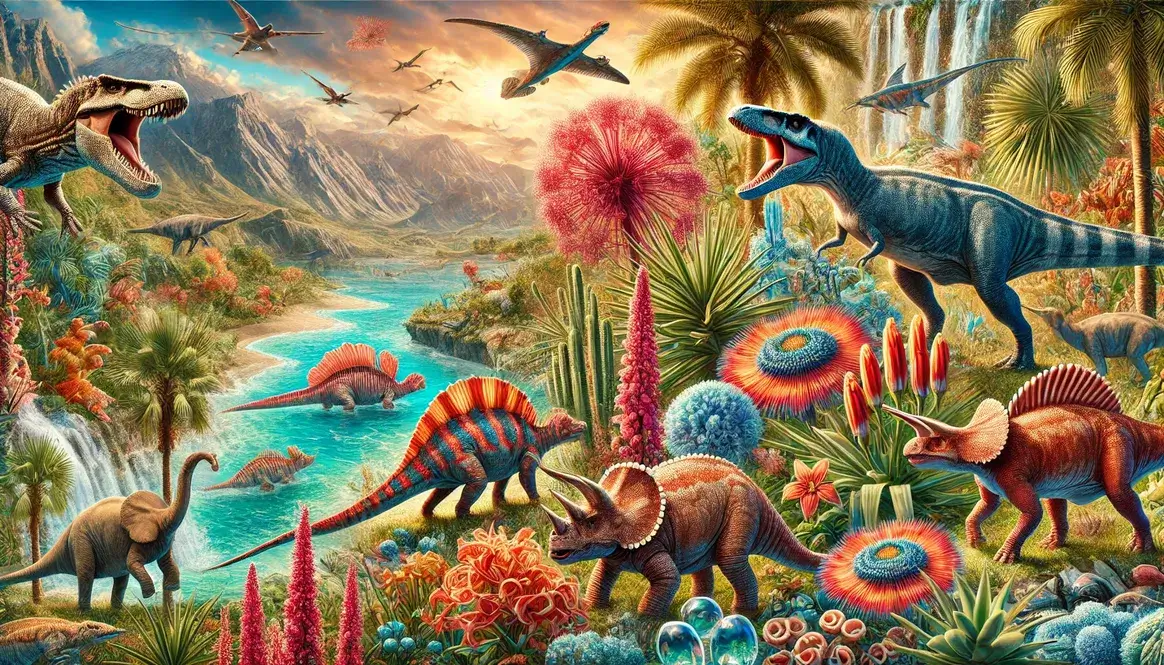Imagine a world where the oceans teemed with strange and wonderful creatures, unlike anything we see today. That’s what Cretaceous ocean life was like! Let’s dive into this fascinating underwater world and meet some of its most interesting inhabitants.
The Cretaceous Seas: A Thriving Underwater World
The Cretaceous period, which lasted from about 145 to 66 million years ago, was a time when the oceans were warm and full of life. These ancient seas covered more of the Earth than they do today, creating vast underwater habitats for all sorts of amazing animals.
During this time, the continents were slowly moving into the positions we recognize today. This movement affected ocean currents and created new environments for sea life to adapt to. The Cretaceous oceans were home to some of the most diverse marine ecosystems in Earth’s history.
Marine Reptiles: Rulers of Cretaceous Oceans
While dinosaurs ruled the land during the Cretaceous, the oceans had their own impressive giants. These weren’t dinosaurs, but rather large marine reptiles that had adapted to life in the water. Let’s meet some of these fascinating creatures!
Mosasaurs: Fierce Predators of the Late Cretaceous
Mosasaurs were some of the most fearsome predators in Cretaceous seas. These giant lizards could grow up to 50 feet long – that’s about as long as a school bus!
Here are some key features of mosasaurs:
- Long, streamlined bodies
- Powerful tails for swimming
- Jaws filled with sharp teeth
- Flippers instead of legs
Mosasaurs were top predators in their ecosystems. They hunted fish, squid, and even other marine reptiles. Some scientists think they might have been able to hunt in groups, like modern orcas do.
Plesiosaurs and Pliosaurs: Long-Necked and Short-Necked Hunters
Plesiosaurs and pliosaurs were two groups of marine reptiles that came in a variety of shapes and sizes.
| Feature | Plesiosaurs | Pliosaurs |
|---|---|---|
| Neck | Long | Short |
| Head | Small | Large |
| Body | Turtle-like | Streamlined |
| Diet | Fish, squid | Large prey |
Plesiosaurs, with their long necks, probably hunted by sneaking up on schools of fish. Pliosaurs, on the other hand, were built for power. Their large heads and strong jaws allowed them to tackle bigger prey, maybe even other marine reptiles!
Ichthyosaurs: Dolphin-Like Marine Reptiles
Ichthyosaurs looked a lot like dolphins, but they weren’t related to them at all. These reptiles had adapted to life in the water in very similar ways to modern dolphins.
Some cool facts about ichthyosaurs:
- They gave birth to live young in the water
- They had large eyes for hunting in deep or dark water
- Some species could dive very deep in search of food
Sadly, ichthyosaurs didn’t make it to the end of the Cretaceous. They went extinct about 90 million years ago, leaving the oceans to the other marine reptiles. Scientists are still trying to figure out why this happened.
Evolution of Modern Fish Groups
The Cretaceous period wasn’t just about big marine reptiles. It was also a time when many of the fish we know today started to take shape. Let’s explore how these underwater creatures evolved and adapted during this exciting time.
Ray-Finned Fishes: Rise to Dominance
Ray-finned fishes, also called teleosts, became the superstars of the Cretaceous oceans. These fish, which make up most of the fish we see today, went through some amazing changes during this time.
One of the coolest things about teleost fish is how they adapted to different environments. Just like plant-eating dinosaurs on land evolved to eat different types of plants, teleost fish evolved to live in all sorts of underwater habitats. Some became fast swimmers in the open ocean, while others adapted to life in coral reefs or river mouths.
Key evolutionary innovations of teleost fishes:
- Flexible jaws: This allowed them to eat a wider variety of food.
- Swim bladders: These gas-filled sacs helped control buoyancy.
- Diverse body shapes: From flat to eel-like, teleosts adapted to many niches.
- Colorful scales: Some species developed bright colors for communication.
These adaptations helped teleost fishes become incredibly successful. By the end of the Cretaceous, they had become the most diverse group of vertebrates on Earth!
Sharks and Rays: Cartilaginous Predators
While bony fish were busy diversifying, sharks and rays were perfecting their predatory lifestyle. These cartilaginous fish had already been around for millions of years, but during the Cretaceous, they evolved into forms we’d recognize today.
Sharks in the Cretaceous seas were a bit different from modern sharks. Many had strange tooth shapes that we don’t see anymore. For example, some had teeth shaped like bananas! Scientists think these might have been used for crushing hard-shelled prey.
Rays, the flat cousins of sharks, also became more diverse during this time. They evolved into many of the types we see today, like stingrays and skates.
| Shark/Ray Group | Cretaceous Innovations | Ecological Role |
|---|---|---|
| Carpet sharks | Camouflage patterns | Bottom-dwelling predators |
| Mackerel sharks | Faster swimming | Open ocean hunters |
| Rays | Flattened bodies | Seafloor foragers |
These cartilaginous fish played important roles in Cretaceous marine ecosystems. They were top predators, keeping the populations of other sea creatures in check. This helped maintain the balance of life in the ancient oceans, much like how T. rex and other Cretaceous predators did on land.
The evolution of these fish groups during the Cretaceous set the stage for the marine life we see today. Next time you visit an aquarium, remember that many of those fish have ancestors that swam alongside mosasaurs and plesiosaurs in the Cretaceous seas!
Invertebrate Fauna: Diversity in Cretaceous Waters
The Cretaceous seas weren’t just home to big, scary reptiles and fish. They were also teeming with a mind-boggling variety of smaller creatures called invertebrates. These animals without backbones played crucial roles in the marine ecosystems of the time.
Ammonites: Iconic Cephalopods of the Cretaceous
If you’ve ever seen a spiral-shaped fossil that looks like a rolled-up snake, chances are you’ve spotted an ammonite! These extinct relatives of modern squid and octopuses were everywhere in the Cretaceous oceans.
Ammonites came in an amazing array of shapes and sizes:
- Typical spiral: The classic ammonite shape
- Straight: Some uncoiled into long, straight shells
- Heteromorphs: Crazy shapes like paperclips or snail-like coils
Size-wise, ammonites ranged from tiny shells smaller than a penny to giants over 2 meters wide! Can you imagine swimming next to an ammonite as big as a car tire?
But ammonites aren’t just cool-looking fossils. They’re super important to paleontologists as index fossils. This means that finding a particular species of ammonite can tell scientists exactly when that rock formed. It’s like a prehistoric timestamp!
Belemnites: Squid-Like Mollusks
While ammonites often steal the spotlight, their cousins the belemnites were also common in Cretaceous seas. These squid-like animals had a hard, bullet-shaped internal shell called a guard. When you find a belemnite fossil, it’s usually just this pointy bit that’s left behind.
Belemnites probably looked a lot like modern squid, with soft bodies and tentacles surrounding their mouths. We know this because some exceptionally well-preserved fossils show impressions of their soft parts!
These swift swimmers were likely important prey for many larger marine animals, forming a crucial link in the Cretaceous food chain. Just as flying creatures in the Cretaceous skies filled different niches, belemnites occupied their own special place in the marine ecosystem.
Rudists: Reef-Building Bivalves
Now, let’s talk about some truly weird creatures: rudists. These bizarre bivalves (relatives of modern clams and oysters) were major reef-builders in the Cretaceous, taking over the role that corals play today in many areas.
Rudists had two very different shells:
- A large, cone-shaped bottom shell attached to the seafloor
- A smaller, lid-like top shell
They grew in dense clusters, forming massive reefs that could stretch for kilometers. These reefs provided homes for countless other marine creatures, much like coral reefs do today.
Other Notable Invertebrates
The Cretaceous seas were home to many other fascinating invertebrates:
- Echinoids: Sea urchins and sand dollars thrived, with some unusual extinct groups.
- Crustaceans: Crabs, lobsters, and shrimp-like animals scuttled across the seafloor.
- Brachiopods: These lamp shell creatures, while less common than in earlier times, still hung on.
- Sponges: Various types of sponges filtered the Cretaceous waters.
- Corals: Although less dominant than today, corals were still present in some areas.
Each of these groups played its part in the rich tapestry of Cretaceous marine life. From the tiniest plankton to the largest ammonites, these invertebrates formed the foundation of complex food webs that supported the larger, more famous creatures of the prehistoric seas.
The diversity of Cretaceous invertebrates reminds us that, just like the major changes happening on land, the oceans were also experiencing significant evolutionary developments during this period.
Marine Ecosystem Dynamics in the Cretaceous
The Cretaceous oceans were buzzing with life, from tiny plankton to enormous marine reptiles. But how did all these creatures interact? Let’s explore the complex world of Cretaceous marine ecosystems.
Food Webs and Trophic Interactions
Imagine a giant underwater game of “who eats who.” That’s basically what a food web is! In the Cretaceous oceans, these food webs were incredibly complex.
At the bottom of the food chain were tiny organisms like phytoplankton. These microscopic plants used sunlight to make food, just like plants on land. They were eaten by slightly larger animals called zooplankton.
From there, the food web branched out:
- Small fish ate the plankton
- Larger fish and some marine reptiles ate the smaller fish
- Top predators like mosasaurs and large sharks ate pretty much anything they could catch!
Energy flowed through this system, passing from one level to the next. But it wasn’t just a simple chain. Many animals ate different things at different stages of their lives, making the food web more like a tangled ball of yarn than a neat ladder.
Environmental Factors Shaping Marine Life
The Cretaceous world was warmer than today, and this had a big impact on ocean life. Warmer waters meant that many creatures could live in areas that would be too cold for them now. It’s a bit like how the Cretaceous climate affected land animals, but underwater!
Ocean chemistry was also different. There was more carbon dioxide in the air, which made the oceans a bit more acidic. This affected animals with shells, like some plankton and mollusks.
Another big factor was sea level. During much of the Cretaceous, sea levels were much higher than they are today. This created vast shallow seas over what are now continents. These shallow seas were perfect homes for many marine creatures.
| Environmental Factor | Effect on Marine Life |
|---|---|
| Warm climate | Expanded habitats for many species |
| Higher CO2 levels | Challenges for some shell-forming organisms |
| High sea levels | Creation of new shallow marine environments |
Cretaceous Marine Biomes
The Cretaceous oceans weren’t just one big, uniform place. They had different environments, or biomes, each with its own set of plants and animals.
- Coral Reefs: While not as common as today, coral reefs did exist. But the biggest reef builders were often rudists, those weird clam-like creatures we talked about earlier.
- Coastal Environments: Shallow seas covered many areas that are dry land today. These waters were full of life, from seaweeds to shellfish to fish and marine reptiles.
- Open Oceans: Far from land, the open oceans were home to large marine reptiles, sharks, and fish. Floating forests of seaweed provided homes for smaller creatures.
Each of these biomes had its own unique inhabitants. Just like different types of dinosaurs lived in different land habitats, marine life was adapted to specific ocean environments.
End-Cretaceous Extinction: Fate of Cretaceous Ocean Life
The end of the Cretaceous period brought big changes to ocean life. About 66 million years ago, a massive asteroid hit the Earth, causing what scientists call the K-Pg extinction event.
This event was devastating for marine life:
- Many groups of marine reptiles, including mosasaurs and plesiosaurs, went extinct.
- Ammonites and belemnites disappeared completely.
- About half of marine plankton species died out.
- Many types of fish, sharks, and rays also went extinct.
But not everything died. Some marine animals managed to survive:
- Bony fish (teleosts) suffered losses but many groups survived.
- Some sharks and rays made it through.
- Animals that could eat a wide variety of food or live in different habitats had better chances.
The survivors of this extinction went on to evolve into many of the ocean animals we see today. Modern whales, for example, evolved to fill some of the niches left by extinct marine reptiles.









